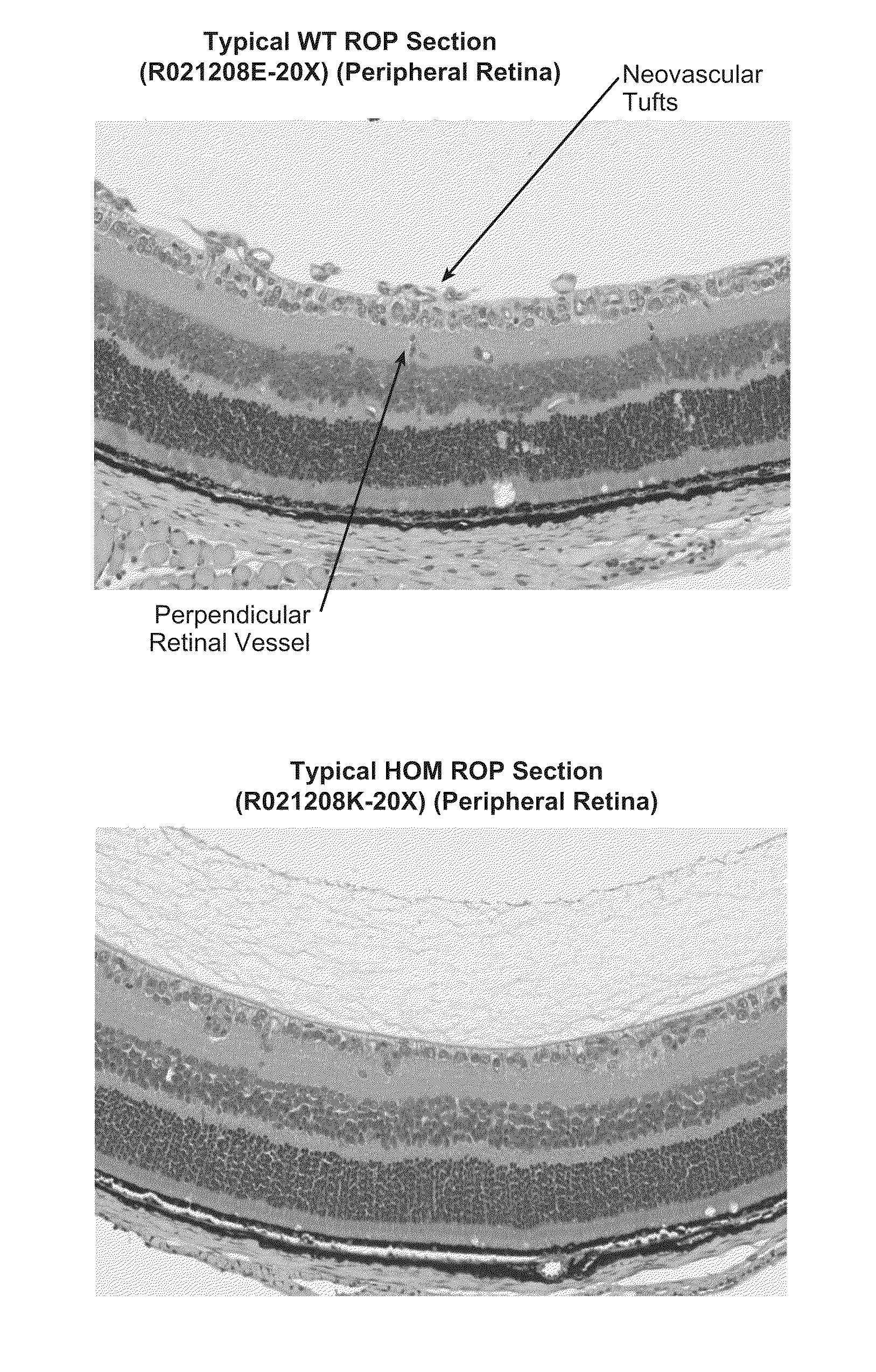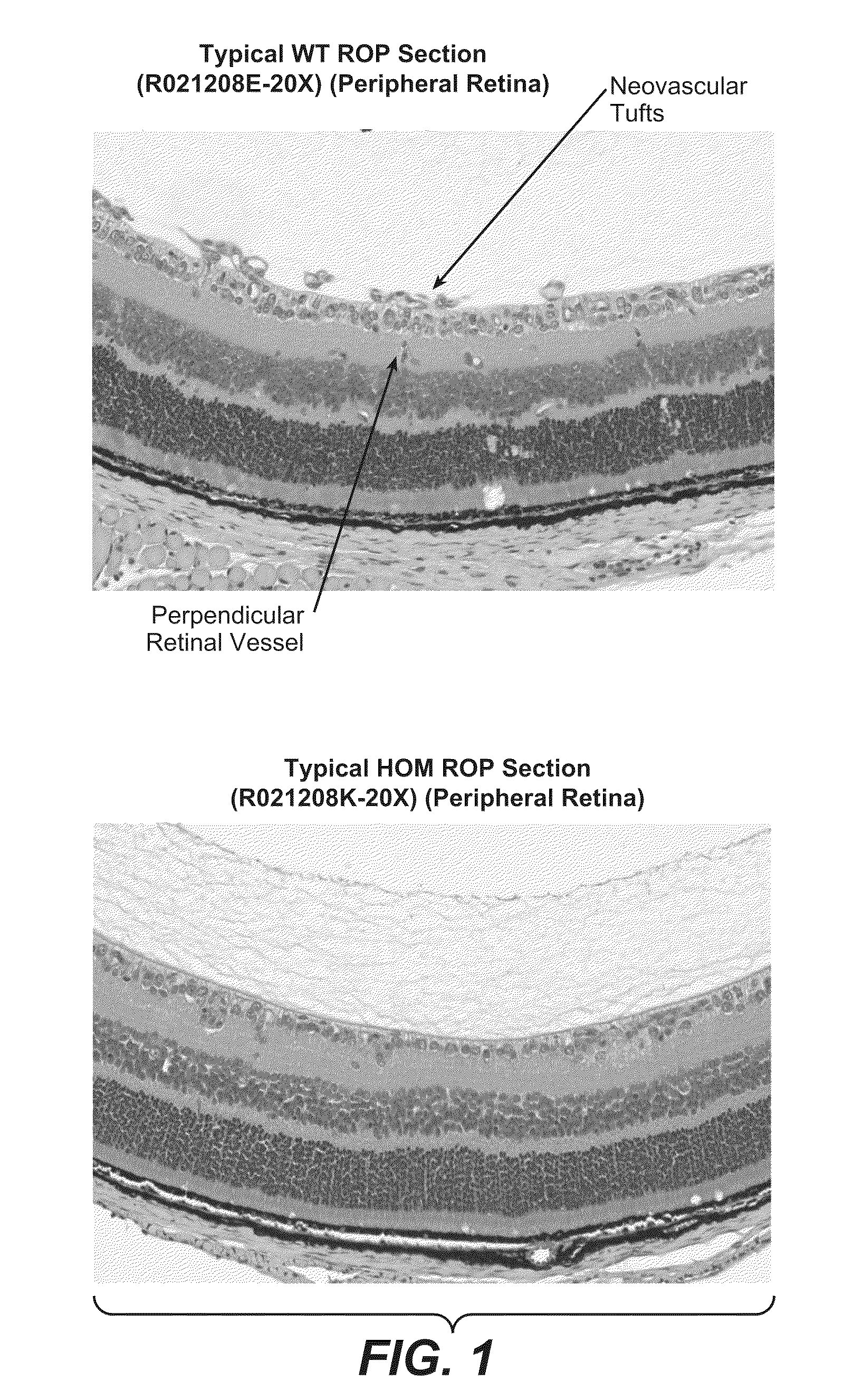Methods for inhibiting ocular angiogenesis
a technology of ocular angiogenesis and inhibition method, which is applied in the field of anti-angiogenesis, can solve the problems of retinal vessel damage and undesirable neovascularization
- Summary
- Abstract
- Description
- Claims
- Application Information
AI Technical Summary
Benefits of technology
Problems solved by technology
Method used
Image
Examples
example 1
TSPAN12 is Involved in Normal and Pathological Angiogenesis
[0152]Although the coding region for TSPAN12 is known in several organisms, including humans and mice (see, e.g., GenBank® Accession Nos. NM—012338 for hTSPAN12 and NM—173007 for mTSPAN12), no function for it has been identified. To begin to elucidate its function, TSPAN12 knockout (KO) mice were generated using conventional methods. Specifically, the targeting construct was electroporated into 129 / SvEvBrd (Lex-2) ES cells and targeted clones were identified using a southern blot assay. Cells from a targeted clone were injected into C57BL / 6 (albino) blastocysts. The resulting chimeras were mated to C57BL / 6 (albino) females to generate mice that were heterozygous for the mutation and subsequently backcrossed onto a C57 / BL6 background (>N3) and used for phenotypic analysis and other experiments. TSPAN12− / − mice were viable and fertile.
[0153]We generated a rabbit polyclonal serum named αTSPAN12-Anaspec-C against the c-terminal ...
example 2
TSPAN12 is Involved in Wnt Signaling
[0160]Based on the similarity between the phenotypes observed in the TSPAN12, Fzd4 and Norrin KO mice, we conducted Topflash reporter assays to determine whether TSPAN12 is involved in Norrin-induced β-catenin Wnt signaling through Fzd4. The Topflash construct consists of firefly luciferase under a promoter containing LEF / TCF consensus sites that is therefore responsive to canonical β-catenin signaling. A construct expressing renilla luciferase under a constitutive promoter is used as internal control. Cells transfected with reporter constructs and receptors were activated with 10 nM recombinant Norrin in the presence of exogenous TSPAN12 or vector control. 16-18 hours later, reporter activity (firefly activity divided by renilla activity) was determined. Norrin-mediated signaling was approximately 4-fold higher in cells overexpressing TSPAN12 than control cells (FIG. 3, left panel—right panel shows that control renilla luciferase expression was t...
example 3
TSPAN12 is Part of the Fzd4-Receptor Complex
[0162]If TSPAN12 indeed functions during initiation of Norrin / β-catenin signaling it would be expected to colocalize and interact with components of the receptor complex. In order to test this possibility we transfected Hela cells with flag-Fzd4 (flag positioned extracellularly) and HA-TSPAN12. Plasma membrane Fzd4 was detected with a flag antibody on non-permeabilized, living cells on ice and TSPAN12 was detected subsequently after fixation and permeabilization. This staining paradigm revealed abundant Fzd4 expression on the surface of Hela cells. Fzd4 was not homogenously dispersed in the plasma membrane but instead was found to be condensed in numerous punctate areas. TSPAN12 colocalized to a large extent with Fzd4 positive punctae, and in addition occurred in intracellular structures that were not stained by the anti-flag antibody because the anti-flag staining was done on the cell surface without permeabilizing the cells. In contrast,...
PUM
| Property | Measurement | Unit |
|---|---|---|
| molecular weight | aaaaa | aaaaa |
| concentration | aaaaa | aaaaa |
| time | aaaaa | aaaaa |
Abstract
Description
Claims
Application Information
 Login to View More
Login to View More - R&D
- Intellectual Property
- Life Sciences
- Materials
- Tech Scout
- Unparalleled Data Quality
- Higher Quality Content
- 60% Fewer Hallucinations
Browse by: Latest US Patents, China's latest patents, Technical Efficacy Thesaurus, Application Domain, Technology Topic, Popular Technical Reports.
© 2025 PatSnap. All rights reserved.Legal|Privacy policy|Modern Slavery Act Transparency Statement|Sitemap|About US| Contact US: help@patsnap.com



